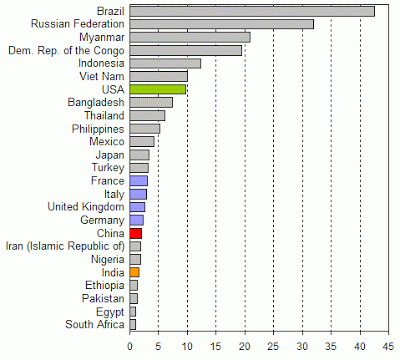Thar Drought: Early Warning of Coming Dust Bowl in Pakistan?
By Riaz Haq
CA
Deaths of dozens of malnourished and sick children after a three-year drought in Pakistan's Thar desert have finally got the media attention and forced politicians to take notice of the unfolding tragedy. Emergency aid is now being provided by the Pakistani military and the civil society. And promises are being made by the politicians to do more for the poor, mostly Hindu, residents of the affected region.
Dust Bowl:
The Thar situation today reminds of what happened during America's Dust Bowl in the 1930s that lasted almost a decade. It forced millions of people in Arkansas, Kansas, Oklahoma, New Mexico, Nevada and Texas to migrate to other parts of the country, particularly California. Drought caused windblown dust and devastation of agriculture in the region. Some believe with good reason that the Dust Bowl accentuated and extended the Great Depression for several more years than would have been the case otherwise.
Here's what John Steinbeck wrote about the Dust Bowl in his 1939 novel The Grapes of Wrath:
"And then the dispossessed were drawn west- from Kansas, Oklahoma, Texas, New Mexico; from Nevada and Arkansas, families, tribes, dusted out, tractored out. Car-loads, caravans, homeless and hungry; twenty thousand and fifty thousand and a hundred thousand and two hundred thousand. They streamed over the mountains, hungry and restless - restless as ants, scurrying to find work to do - to lift, to push, to pull, to pick, to cut - anything, any burden to bear, for food. The kids are hungry. We got no place to live. Like ants scurrying for work, for food, and most of all for land."
Like the residents of the American plains affected by the Dust Bowl in 1930s, the people of Thar desert region rely on their crops and livestock for their livelihood. Since there is a very limited irrigation system in the area, they depend almost entirely on rains to grow their crops and raise cattle.
The area currently affected by drought is relatively small but it could expand rapidly and turn into a much bigger tragedy unless the government and the people wake up to it. In addition to providing immediate relief, there is a strong need for a longer term strategy to improve water storage and irrigation in the region.
It's not just the Thar region. The problem that needs to be addressed is much bigger. Pakistan has increasingly been suffering from cycles of severe droughts followed by massive floods in the last few years. This recurring pattern of shortage and excess of water gives us a preview of the growing challenge of climate change . This situation calls for a comprehensive water management effort to deal with a potentially existential threat to Pakistan.
Flood-Drought Cycles:
Before the summer floods of 2010, the Indus had turned into a muddy puddle in parts of Sindh. Britain's Financial Times reported at the time that "angry farmers marched through villages in Sindh demanding access to water. Those who can no longer turn a profit in the fields are increasingly resorting to banditry or migrating to urban shanties".
Earlier, there was a 2009 report by the Woodrow Wilson International Center saying that the melting Himalayan glaciers had exacerbated Pakistan’s shortages. And the World Bank warned that Pakistan could face a “terrifying” 30-40 per cent drop in river flows in 100 years time. Now large parts of Sindh are under water for the second year in a row, destroying lives and standing crops.
Growing Water Scarcity:

According to the United Nations' World Water Development Report , the total actual renewable water resources in Pakistan decreased from 2,961 cubic meters per capita in 2000 to 1,420 cubic meters in 2005. A more recent study indicates an available supply of water of little more than 1,000 cubic meters per person, which puts Pakistan in the category of a high stress country. Using data from the Pakistan's federal government's Planning and Development Division, the overall water availability has decreased from 1,299 cubic meters per capita in 1996-97 to 1,101 cubic meters in 2004-05. In view of growing population, urbanization and increased industrialization, the situation is likely to get worse. If the current trends continue, it could go as lows as 550-cubic meters by 2025. Nevertheless, excessive mining of groundwater goes on. Despite a lowering water table, the annual growth rate of electric tube wells has been 6.7% and for diesel tube wells about 7.4%. In addition, increasing pollution and saltwater intrusion threaten the country's water resources. About 36% of the groundwater is classified as highly saline.
So what can Pakistan do to manage these disastrous cycles of floods and droughts?
1. Build Dams and Dykes:
As the flood disaster takes its toll yet again, there are reports of USAID and ADB considering funding the $12 billion Bhasha Dam in Pakistan. The project is located on Indus River, about 200 miles upstream of the existing Tarbela Dam, 100 miles downstream from the Northern Area capital Gilgit in Gilgit-Baltistan region. The dam's reservoir would hold so much water that it could have averted last year's devastating floods. It would also provide enough electricity to end Pakistan's crippling shortages , according to a report in the Guardian newspaper . The massive dam on the Indus river would provide 4,500MW of renewable energy, making up for a shortfall causing up to 12 hours of load-shedding on daily basis across Pakistan. The reservoir would be 50 miles long, holding 8.5 MAF (million acre feet) of water.
In addition to large dams, there is also a need to build and maintain dykes and start other flood-control projects in flood-prone areas like Badin and Thatta in Sindh.
2. Conserve Water:
Building Bhasha and several other proposed dams will help in dealing with water scarcity, but the growing population will continue to put pressure on the vital resource .
Serious conservation steps need to be taken to improve the efficiency of water use in Pakistani agriculture which claims almost all of the available fresh water resources. A California study recently found that water use efficiency ranged from 60%-85% for surface irrigation to 70%-90% for sprinkler irrigation and 88%-90% for drip irrigation. Potential savings would be even higher if the technology switch were combined with more precise irrigation scheduling and a partial shift from lower-value, water-intensive crops to higher-value, more water-efficient crops. Rather than the flood irrigation method currently used in Pakistani agriculture, there is a need to explore the use of drip or spray irrigation to make better use of the nation's scarce water resources before it is too late. As a first step toward improving efficiency, Pakistan government launched in 2006 a US $1.3 billion drip irrigation program that could help reduce water waste over the next five years. Early results are encouraging. "We installed a model drip irrigation system here that was used to irrigate cotton and the experiment was highly successful. The cotton yield with drip irrigation ranged from 1,520 kg to 1,680 kg per acre compared to 960 kg from the traditional flood irrigation method," according to Wajid Ishaq, a junior scientist at the Nuclear Institute for Agriculture and Biology(NIAB).

Beyond the government-funded experiments, there is a drip irrigation company called Micro Drip which is funded by the Acumen Fund . Micro Drip develops and provides products and services as poverty-alleviation solutions to small farmers in Pakistan’s arid regions. It provides a complete drip irrigation system along with agricultural training and after-sales support to enable farmers to extract a higher yield from their land at a much lower cost of input.
So what is holding up Pakistan's progress on water management?
1. Lack of Funds:
Pakistani government revenues continue to be limited by slow economic growth and widespread culture of tax evasion . The biggest culprits are the ruling feudal politicians who oppose any attempt to levy taxes on their farm income. The limited resources the state does have are usually squandered on political patronage doled out to ruling politicians' supporters in the form of capricious grants, huge loans (defaulted with impunity), and plum jobs in bloated government and the money-losing state-owned enterprises. The result of this blatant abuse, waste and fraud is that the budget allocations for vital long-term investments in education, health care and infrastructure development projects are regularly slashed, thereby shortchanging the future of the nation.
2. Corruption and Security Concerns:
The NY Times has reported that "Washington’s fears of Pakistani corruption and incompetence has slowed disbursal of the money". The story reinforces the widely-held view that even after the funding is arranged, the corrupt and incompetent politicians and their hand-picked civilian administrators make any development progress slow and difficult. Such problems are further exacerbated by significant security issues in parts of the country severely plagued by ongoing militancy.
Existential Threat:
It can be argued that the threat from climate change is bigger than the Taliban threat which gets all the coverage in Pakistan. Generations of military families have periodically fought FATA insurgencies. For example, Shuja Nawaz, the author of Crossed Swords says that his grandfather, his uncle and his cousin have all been deployed in Waziristan by the British and later Pakistani governments in the last century and a half. Pakistani military is quite capable of dealing with this threat to defeat the Taliban .
Climate change and the growing water scarcity pose a bigger long-term existential threat to Pakistan and the region. Water per capita is already down below 1000 cubic meters and declining. What Pakistan needs are major 1960s style investments for a second Green Revolution to avoid the specter of mass starvation and political upheaval it will bring.
Conclusion:
As to the current Thar crisis, corruption, incompetence and poor governance have characterized the Pakistan People's Party rule at the federal level and in the Sindh province for years. What is happening in Tharparkar now is symptomatic of it. The PPP voters in Sind, particularly in Tharparkar, are mostly poor haris many of whom are followers of powerful landowning feudal pirs who represent them in the Sindh Assembly and in the national parliament. The voters never hold their representatives accountable for the total neglect of their areas. Instead, the powerful and ubiquitous media born on Musharraf's watch is doing it, as are the Supreme Court judges.
I think it's a good development in Pakistan which will likely help the poor who have so far been helpless. I hope that the media focus is not just on the current crisis in Thar at the provincial level but also on the larger national issues of water management, storage and irrigation infrastructure that the country needs to avert a much bigger disaster in the future.
------------------------------------------------------------------------------
Back to Pakistanlink Homepage

